
|
|

January 9, 2009
The Helderbergs, Albany, NY
(Originally published on Site of the Week June 15 & 22, 2007)
So here we are at a most exciting moment in broadcast history, just a few weeks away from the end of full-power analog TV broadcasting in the US, unless, of course, the new Congress changes the date. Until they do that, though, we'll continue to devote the next few weeks of Site of the Week - from now until (maybe) transition week, February 17, 2009 - to a look back at some of the more significant sites in Northeast analog TV history. This week: Albany!
In many markets, the changes resulting from the TV transition will be subtle - antennas coming and going from existing towers, transmitters moving in and out of existing buildings, but nothing more that the casual observer would notice.
Not so in Albany, where all of the market's broadcasters got together a few years back and decided that if DTV was going to be a reality in their market, it would bring with it a completely new shared transmission facility for everyone.

|
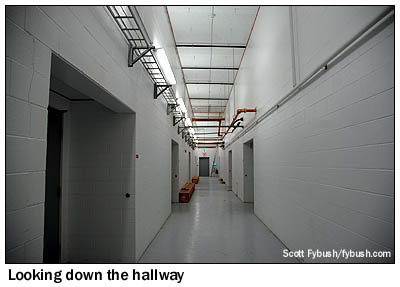
|
When planning for this project began in 1997, each of Albany's six major TV stations operated its own separate transmitter plant. Five stations - Freedom's CBS affiliate WRGB (Channel 6), Young's ABC affiliate WTEN (Channel 10), PBS outlet WMHT (Channel 17), Clear Channel's Fox affiliate WXXA (Channel 23) and Tribune's WB affiliate WEWB (Channel 45) were located at various spots around the Helderberg plateau, the hill southwest of Albany that's been home to TV and FM in the market since the forties. Hubbard's NBC affiliate WNYT (Channel 13), constrained by short-spacings to stations in Rochester and New York, was east of Albany on Bald Mountain. But with no spacing issues for DTV operations, WNYT joined in the Capital Region Broadcasters consortium, which spent some $5 million to build a new site in the Helderbergs from scratch.
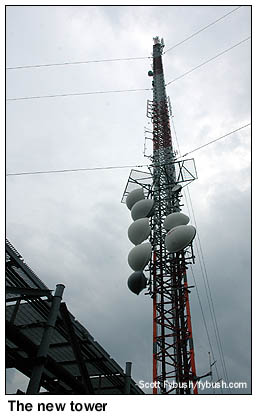
|

|
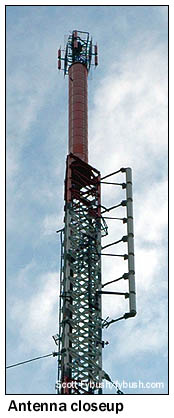
|
There were a few more issues that needed to be resolved before the facility could get underway: WXXA was assigned DTV channel 4, an undesirable low-band channel that would have required a separate antenna, and it took several years to get WXXA reassigned to channel 7, where it could share a high-band VHF master antenna with WNYT-DT's channel 12. WRGB-DT 39, WTEN-DT 26 and WMHT-DT 34 were able to share a UHF master antenna, and WEWB (which was renamed WCWN when it became a CW outlet, and was eventually sold to Freedom) decided to move its analog channel 45 operation to this site as well, combining it and WCWN-DT 43 into a side-mounted antenna just below the VHF and UHF master antennas.
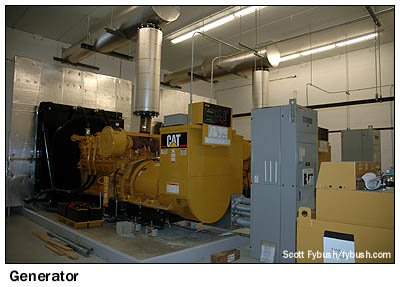
|
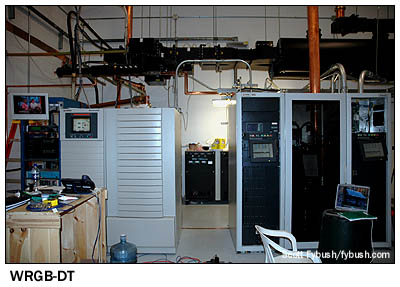
|
A June 2006 visit to the new building and the new 500' tower brought us inside most of the transmitter rooms, starting at WRGB, where engineers were working on one of the two transmitters. Down the hall, there's a huge generator room that can keep all these signals on the air no matter what's going on outside. Across the hall, the VHF combiner for 7 and 12 is floor-mounted in the combiner room, while the UHF combiner for 26, 34 and 39 hangs from the ceiling to save space. (This room also houses some government two-way gear.)

|
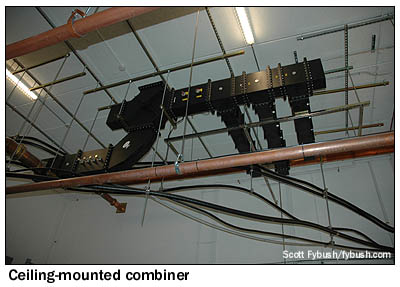
|
These rooms are very large, providing lots of expansion space for whatever comes next - and in the meantime, as you can see from the photos below, there's lots of empty space around most of these transmitters. (In our travels so far, we've only seen two other DTV sites that were so comprehensively designed to serve most or all of a market's DTV needs - the new DTV site in Syracuse, which ended up with only a few signals on it so far, and the WBZ digital facility in Boston, which was designed for four stations with room for several more. Any nominations for others we should see?)

|
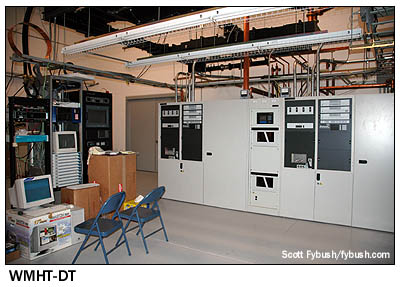
|
The smallest, at least for now, is the Rohde and Schwartz channel 7 transmitter at WXXA-DT - and the most crowded room, unsurprisingly, is WCWN's, since it's housing both an analog and a digital transmitter.
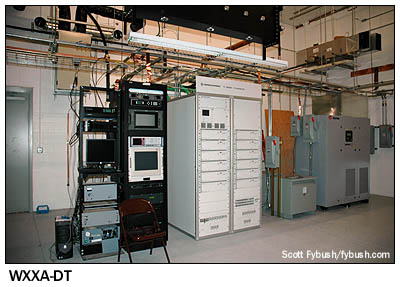
|

|
The next step in Albany's DTV conversion will come in 2009, when most of these stations are expected to take their current sites dark. The one "what if" in the picture is WRGB, the only Albany DTV that's elected to stay on its current channel, 6, rather than its interim DTV channel, 39. At the time of our tour, nobody was certain whether WRGB would use its current analog site for DTV, or whether a new antenna will go up at this site for channel 6.
(2009 update: We now understand that WRGB-DT will use this site for digital channel 6, putting up a new panel antenna in the tower aperture now used by WCWN/WCWN-DT. WCWN-DT, meanwhile, will take over WRGB-DT's current transmitter, retuning it from 39 to 43, and its combiner port into the master antenna at the top of the tower. And with that, on to the analog sites...)
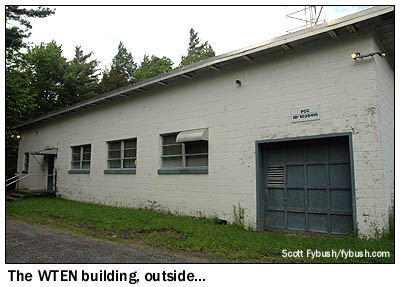
|
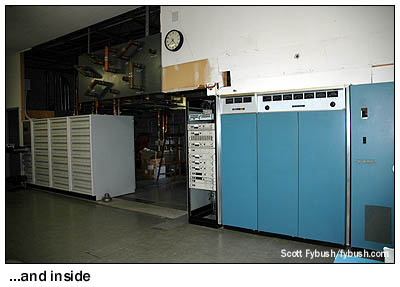
|
History? You betcha. The Helderberg Mountains, just south and west of Albany, have been home to FM and TV in this market almost since the dawn of FM and TV. General Electric's WRGB-TV was up here as early as the late thirties, as was FM outlet W2XOY, and by 1941, an independent FM station, W47A (44.7) was operating from here as well.
W47A didn't make it (though another independent FM station, WFLY 92.3, appeared up here not long after the war), and we'll come back to the WRGB story in a bit - but for now we'll turn to the second TV station to broadcast from this plateau some 1500 feet above sea level.
WTEN (Channel 10) signed on from here in 1963, but its history goes back nine years earlier. WROW-TV had signed on as channel 41 in 1954, from a tower north of Albany on the banks of the Hudson River. It soon became WCDA, spawning a three-station network that also included WCDB (Channel 29) in Hagaman, near Amsterdam, and WCDC (Channel 19) in Adams, Mass. In 1957, it moved to channel 10, initially licensed to Vails Mills, also up near Amsterdam, making WCDB superfluous, and it took some tussles with Rochester's channel 10 (WVET/WHEC) over spacing issues to finally land the renamed WTEN here at the best of all sites for Albany TV.
(Albany's third VHF station, then known as WAST channel 13, never did get up here; it had been WTRI on channel 35 before getting the channel 13 authorization in 1958. Because of short spacing to channel 13 in Newark, N.J., WAST remained at the old WTRI site on Bald Mountain east of Troy. Only with the coming of DTV did the station, now WNYT, get up here for its digital signal.)
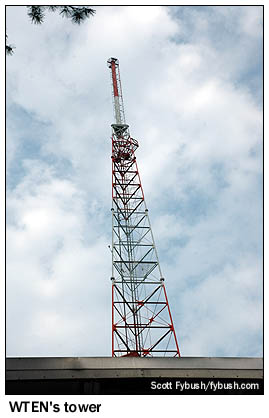
|
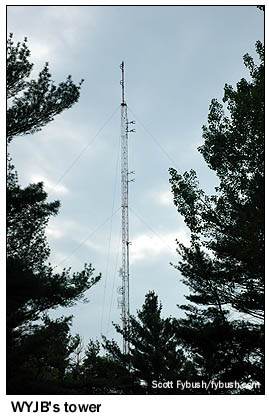
|

|
WTEN's 1963 site sits at the end of "TV Lane," which runs east from Pinnacle Road, the north-south axis that connects most of the sites up here. From the outside, it looks pretty much the same as it must have appeared back then; inside, a modern Harris transmitter sits in the space that was probably filled by a huge GE transmitter back in the day.
WTEN, we should note, was owned in 1963 (and for many years thereafter) by a little firm called Capital Cities, which also owned WROW (590) and WROW-FM (95.5), and which would later go on, 23 years later, to swallow ABC. Today, WTEN is owned by Young Broadcasting, while the former WROW-FM is now Albany Broadcasting's WYJB. It transmits from a tower on TV Lane just west of the WTEN site. In addition to WYJB's two-bay antenna at the top of the tower and its one-bay aux down near the bottom, this tower now holds two newer signals: WAJZ (96.3 Voorheesville) and WZMR (104.9 Altamont, itself a move-in from the west, having come in to the Albany market from Johnstown a few years back.)
Behind the WTEN tower sits WGNA (107.7), another venerable Helderbergs FM, and while we didn't get any good pictures of it this time, the WFLY site sits just a few hundred feet away to the north. (Is WFLY's site the same location used by W47A back in the day? I'm not sure; the W47A building shown on Norm Gagnon's GGNInfo.com site doesn't seem to exist any longer, in any event.)
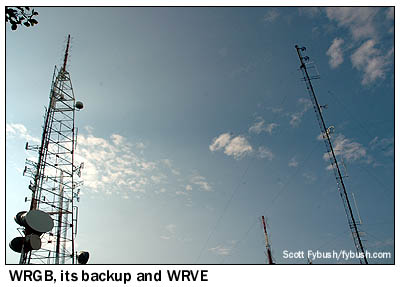
|
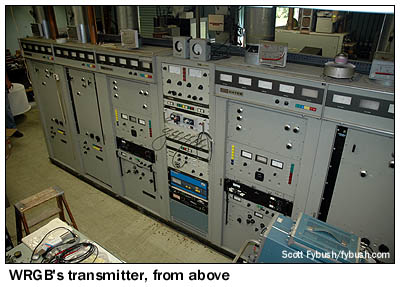
|
From WTEN, we head north to the end of Pinnacle Road, overlooking the steep dropoff that presents a dramatic vista of Albany and Schenectady, and east on Beaver Dam Road to the gate that leads back up the hill to the WRGB site, the easternmost of the Helderbergs towers.
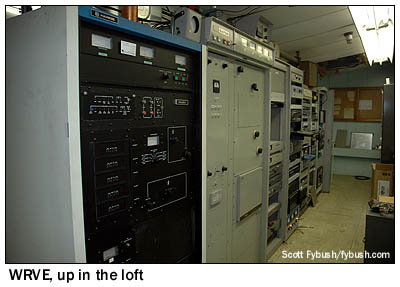 Here,
too, there's no sign at all of the early
building pictured on GGNInfo, nor of the short towers on
which the early GE engineers mounted their experimental antennas.
Here,
too, there's no sign at all of the early
building pictured on GGNInfo, nor of the short towers on
which the early GE engineers mounted their experimental antennas.
Instead, there's a building that looks like a green metal garage - and no GE transmitter inside, either. (GE hasn't owned WRGB since the eighties; it's now owned by Freedom.)
That Gates BT-18 is carrying analog channel 6 to the end of its days - and up a spiral staircase, on a narrow loft overlooking the Gates, we find the transmitters for WRGB's former sister station. It even says "WGFM" on one of them, but the 99.5 signal here is today Clear Channel's WRVE, and I'm pretty sure there's now an HD transmitter up here instead of that vintage Gates next to what was then the Harris main transmitter.
Also tucked in here is WNYA-CA (Channel 15), the LPTV that relays My Network TV affiliate WNYA (Channel 51) from Pittsfield, Mass. When we visited a year ago, WNYA was being operated out of the WRGB studios, but now that WRGB has purchased CW affiliate WCWN (Channel 45) as a sister station, that's changing, we think.
(The historian in us would note, too, that a plan was floated back in the fifties to make Albany an all-UHF market, moving WRGB to channel 47 alongside the existing channels 35 and 41, but GE's political power quashed that idea.)
2009 update - We understand that the current WRGB analog building and tower will end up being reused by WNYA-DT, on channel 13.
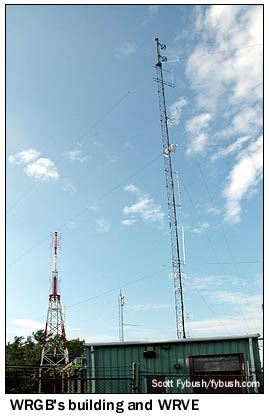
|
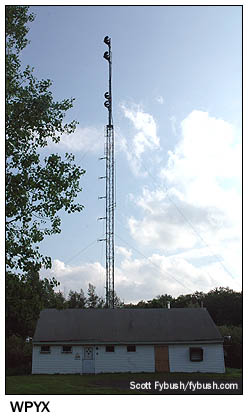
|
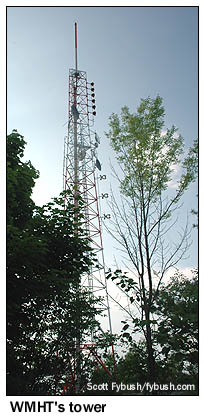
|
Outside the building, we spend a few minutes admiring the cluster of towers here - a very solid-looking self-supporter for WRGB, a short aux tower for WRGB that looks as though it could date back to the early days here, and the guyed WRVE tower right behind the building - before returning to Pinnacle Road to see the towers on its west side.
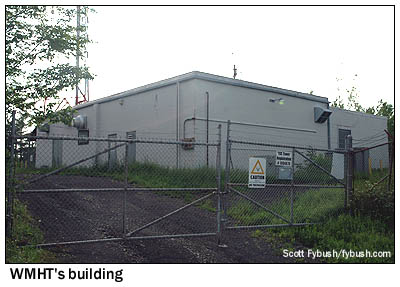 The
first building on the west side of Pinnacle, heading south from
Beaver Dam, is the oldest of Albany's current UHF stations.
The
first building on the west side of Pinnacle, heading south from
Beaver Dam, is the oldest of Albany's current UHF stations.
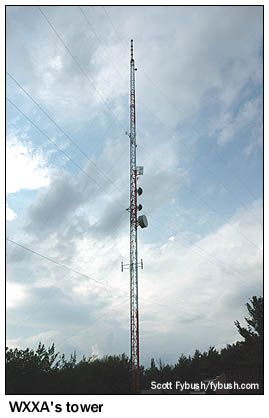 WMHT
(Channel 17) signed on in 1962 as one of the state's first public
TV stations, and its tower now holds not only WMHT-TV but also
two FMs - Siena College's WVCR (88.3) and WMHT's own FM outlet,
which signed on in 1972 on 89.1, usurping WVCR's former frequency
in exchange for a deal to raise that station's power and move
it to the Helderbergs on 88.3.
WMHT
(Channel 17) signed on in 1962 as one of the state's first public
TV stations, and its tower now holds not only WMHT-TV but also
two FMs - Siena College's WVCR (88.3) and WMHT's own FM outlet,
which signed on in 1972 on 89.1, usurping WVCR's former frequency
in exchange for a deal to raise that station's power and move
it to the Helderbergs on 88.3.
Next door to WMHT is the little ranch-house style building that's home to WPYX (106.5), with its tower right out back.
From there, it's about half a mile south (and uphill) to the newer towers in the cluster, starting with the former site of channel 45, which signed on as indie WUSV in the 80s, was sold to WMHT as public station WMHX a few years later, went dark, returned as public station WMHQ, then went commercial as WEWB and then WCWN. By then, as we showed you last week, 45's analog signal had moved to the new DTV tower that went up on the next parcel to the south. (The old 45 tower is on "Tower Two Lane," while the new stick is on "Tower Three Lane.")
Another half-mile or so brings us to the southernmost of the sites up here: the analog tower for Fox outlet WXXA (Channel 23), which signed on in 1982. It suffered a disastrous antenna failure a few years back, and the burned-up old antenna now sits in the grass outside the building.
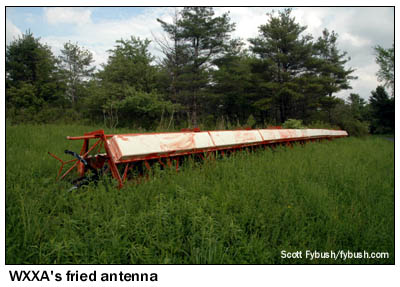
|
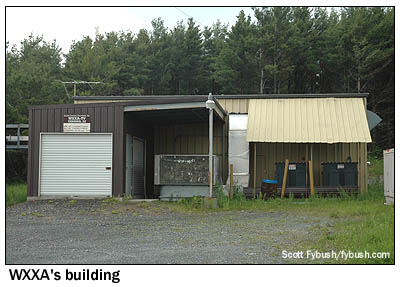
|
And that, save for a look inside the WXXA analog building (which we'll get someday, though the station's CE is on a well-deserved vacation during this visit), is pretty much all there is to show you about TV up here in the Helderbergs.
Thanks to Arthur Neveu of WTEN, Eric Brucker and Fred Lass of WRGB, Sarge Cathrall of WXXA and Derk van Rijsewijk of WMHT for the tours, and for arranging for the tours!
- Previous Site of the Week: WBZ-TV, Needham, MA
- Next Week: Ingraham Hill, Binghamton
- Site of the Week INDEX!
- How can you help support Site of the Week? Click here!
- Submit your suggestions for a future Site of the Week!
